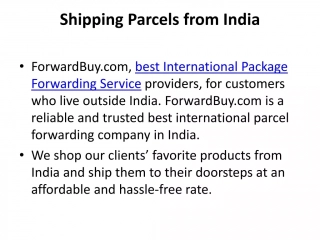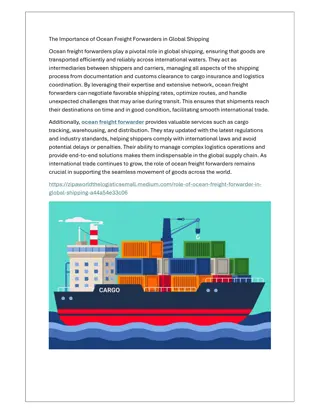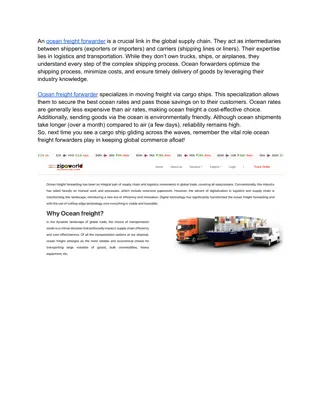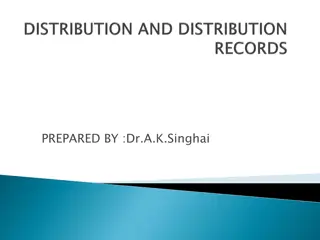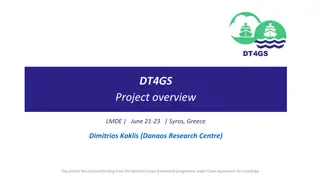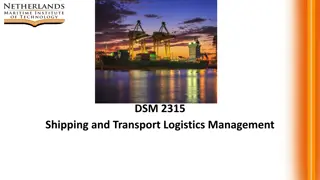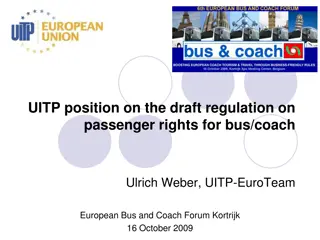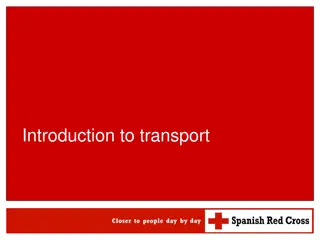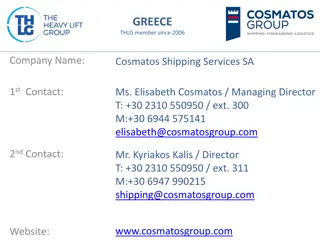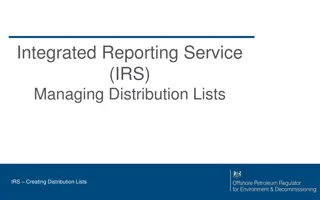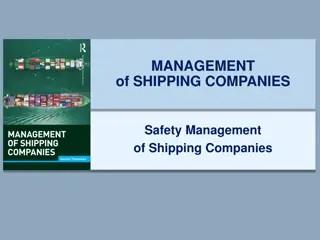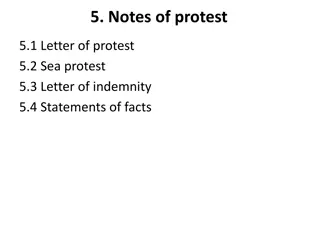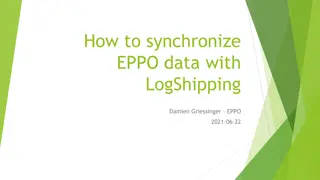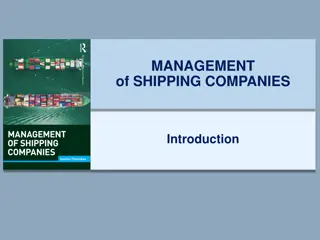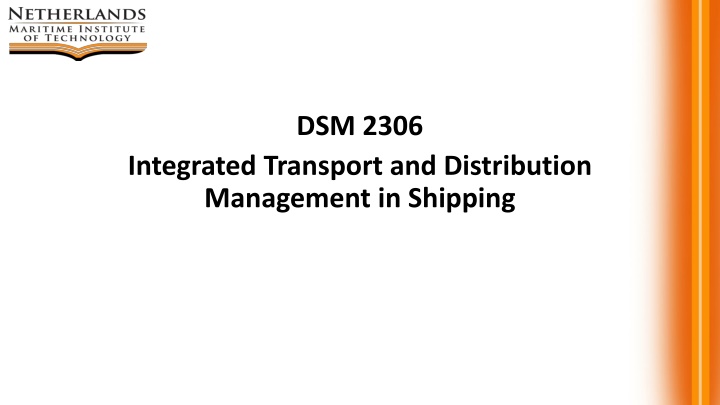
Integrated Transport and Distribution Management in Shipping
This course covers logistical management, integrated systems, ship handling, maritime transportation, intermodalism, and customer service in the context of shipping. Students will learn about the challenges and evolving trends in the global shipping industry, with a focus on optimizing shipping services efficiency. The course emphasizes the interdependence of freight transactions and logistical activities, as well as the concept of integrated transport and distribution management discipline.
Download Presentation

Please find below an Image/Link to download the presentation.
The content on the website is provided AS IS for your information and personal use only. It may not be sold, licensed, or shared on other websites without obtaining consent from the author. If you encounter any issues during the download, it is possible that the publisher has removed the file from their server.
You are allowed to download the files provided on this website for personal or commercial use, subject to the condition that they are used lawfully. All files are the property of their respective owners.
The content on the website is provided AS IS for your information and personal use only. It may not be sold, licensed, or shared on other websites without obtaining consent from the author.
E N D
Presentation Transcript
DSM 2306 Integrated Transport and Distribution Management in Shipping
Topics 1. Integrated distribution management (6L, 2T, 14SDL) 1.1 Introduction to logistical management in shipping 1.2 Integrated logistic in a competitive shipping environment 1.3 Logistic in a shipping channel context: adjustment, transfer, storage, handling and shipping 1.4 The channel wide logistical process 1.5 The nature of logistical and shipping channels 1.6 The concept of channel distribution separation 1.7 Interdependence of freight transaction and logistical activities 2. The components of logistical systems (4L, 2T, 10SDL) 2.1 Inter organisational distribution channels 2.2 Typical integrated logistical & shipping systems: Echelon system, Direct system, Flexible systems and Voyager Estimate System (VES) 2.3 Introduction to geo market differentials total logistical channels: production, handling, distribution and shipping
Topics 3. Element of ship handling and materials handling (4L, 2T, 14SDL) 3.1 Advantages of information ship directed handling 3.2 Understanding methods of containerisation: rigid and non rigid containerization and palletisation 3.3 Container handling equipments 3.4 Conventional and Specialised Transport (CST) 4. Transportation and distribution in maritime industry (6L, 3T, 15SDL) 4.1 Introduction to Total Distribution Administration, warehouse, transport decision. 4.2 Maritime and total transportation: the legislative background 4.3 Shipping marginal social cost pricing concept: arbitrary pricing, average cost Pricing, infrastructure costs, land and sea costs. 4.4 Sea and land transport policy: transport policy white paper 4.5 Sea transport: Movement costs, containerisation, cargo handling, port Expenses, freight Costs (TDC): transportation modes,
Topics 5. Intermodalism (4L, 2T, 15SDL) 5.1 Definition 5.2 Elements/Types 5.3 Intermodalism and seamless logistics 5.4 Advantages and disadvantages 5.5 Intermodalism and Integrated transport relationship 6. Customer Service (4L, 2T, 10SDL) 6.1 Define customer service. 6.2 Show the central role that customer service plays in an organization s marketing and logistics efforts. 6.3 How to calculate cost-revenue trade-offs. 6.4 Identify opportunities for improving customer service performance.
Objective To ensure the student encompasses the cognitive process which is remembering, and explaining the features of integrated transport and distribution management in shipping, to explore the problem, and the various related elements involving the integrated transport and distribution management in shipping.
Learning Outcome Define the characteristics of integrated transport and distribution management in shipping Identify the challenges involving the integrated transport and distribution management in optimising and improving the shipping services efficiency Describe the evolving matters in the integrated global shipping industry Demonstrate the concept of integrated transport and distribution management discipline in shipping Describe the various elements of integrated transport and distribution management towards achieving seamless operational efficiency
Always Ask Who What Why How When Where
References Integrated logistic Handbook (3rd ed.).James Jones McGrawhill 2006 Strategic Logistics Management, 4thEdition, James R. Stock & Douglas M. Lambert, McGraw-Hill Irwin, International Edition 2001. Shipping and Logistics Management, Y.H.V. Lun, K.H. Lai, T.C.E. Cheng, 2010 Lloyd s Practical Shipping Guide - Introduction to Marine Cargo Management, J. Mark Rowbotham, Informa 2008. Additional references supporting the course Ports, cities, and global supply chains (transport and mobility).James Wang et al.Ashgate Publishing, Ltd. 2007 Getting the goods: ports, labor, and the logistics revolution. Edna Bonacich & Jake B. Wilson Cornell University Press. 2007 The Handbook of Logistics and Distribution Management, 5th Edition Alan Rushton, Phil Croucher & Dr Peter Baker Kogan Page. 2014
Assessment Methods and Types Quiz 10% - written Test 20% - written Assignment 30% Final Examination 40% - written - written
Grading Scheme Marking Range 90-100 80-89 75-79 Grade Point 4.00 4.00 3.67 Grade Result Pass Pass Pass Exam Eligibility A+ A A- 70-74 65-69 60-64 3.33 3.00 2.67 B+ B B- Pass Pass Pass 55-59 2.33 C+ Pass 50-54 47-49 44-46 2.00 1.67 1.33 C C- D+ Pass Fail Fail Supplementary Supplementary 40-43 30-39 0-29 1.00 0.67 0.00 D E F Fail Fail Fail Supplementary Re-take Re-take
Rules of Class Attendance Mobile Phone to silent mode No talking during lecture Centralized dissemination of notes
1. Integrated distribution management 1.1 Introduction to logistical management in shipping
Logistics What is logistics The Oxford English Dictionary defines logistics as "the branch of military science relating to procuring, maintaining and transporting material, personnel and facilities." Council of Logistics Management definition: Logistics is that part of the supply chain process that plans, implements, and controls the efficient, effective forward and reverse flow and storage of goods, services, and related information between the point of origin and the point of consumption in order to meet customers requirements. Logistic vs Logistics Importance of Logistics Activities? Economic Development Business Growth Matching supply and demand
Logistics Management Synonyms: Logistical Management Business Logistics Logistics Channel Management Materials Management Distribution Management Physical Distribution Industrial Logistics Quick-response systems Supply Chain Management
Logistics Functions Customer Service Procurement Demand Forecasting Production planning/scheduling Inventory Management Logistics Communications Materials Handling Order Processing Packaging (for shipment and storage) Parts and Service Support (after sales) Plant and Warehouse (Site Selection) Procurement (e.g. sourcing, quotations) Reverse Logistics (e.g. remanufacturing, refurbishment, salvage & scrap disposal) Traffic and Transportation Warehousing and Storage
Exercise/Discussion 1 Organise flow of Logistics activities Flow progresses from upstream (raw material) to downstream (the end-customer)
1. Integrated distribution management 1.2 Integrated logistics in a competitive shipping environment
Integrated Logistics Management Cross-Functional Teamwork inside and/or outside the Company Building Channel Partnerships - teamwork Third-Party Logistics A third-party logistics provider (abbreviated 3PL, or sometimes TPL) is a firm that provides service to its customers of outsourced (or "third party") logistics services for part, or all of their supply chain management functions. Third party logistics providers typically specialize in integrated operation, warehousing and transportation services that can be scaled and customized to customers' needs based on market conditions and the demands and delivery service requirements for their products and materials.
Transportation Modes Rail - Nation s largest carrier, cost-effective for shipping bulk products, piggyback (trailer on flatcar -TOFC) Truck Flexible in routing & time schedules, efficient for short- hauls of high value goods Water Low cost for shipping bulky, low-value goods, slowest form Pipeline Ship petroleum, natural gas, and chemicals from sources to markets Air High cost, but efficient for long-hauls of high value goods
Exercise/Discussion 2 Discuss the differences between Logistics vs Transport
1. Integrated distribution management 1.3 Logistic in a shipping channel context: adjustment, transfer, storage, handling and shipping
Logistics Channel Logistics channel The network of intermediaries engaged in adjustment, transfer, storage, handling, and communications functions that contribute to the efficient flow of goods.
Logistics Functions Functions: Adjustment - Consolidation of goods into one cargo shipment / containers or Break Bulk repacked into smaller separable unit Breaking bulk. Wholesalers and retailers purchase large quantities of goods from manufacturers but sell only one or a few at a time to many different customers. (Cross docking) Transfer movement of cargo shipment / container from packing /consolidation areas to warehouse Storage warehousing of cargo shipment / container Handling movement of cargo shipment / container from warehouse to carrier (e.g. ship) Shipping transportation by sea or other modes of transportation
1. Integrated distribution management 1.4 The channel wide logistical process
1. Integrated distribution management 1.5 The nature of logistical and shipping channels
The nature of distribution channels What is distribution channel? Why are intermediaries used? The function of distribution channel Channel level
What is distribution channel? A set of interdependent organizations (intermediaries) involved in the process of making a product or service available for use or consumption by the consumer or business user. Distribution Channels comprised of various players in the flow of products : Producer to Consumer Channel decisions Efficiency of distribution costs Affecting marketing decisions - Intermediaries are specialists in selling, have the contacts, experience and scale of operation which means greater sales can be achieved than if the producing business tried to run a sales operation itself. Involve long-term commitments
How a Distributor Reduces the Number of Channel Transactions 1 2 3 4 A. Number of contacts without a distributor M x C = 3 X 3 = 9 5 6 7 8 9 = Manufacturer = Customer
How a Distributor Reduces the Number of Channel Transactions 1 B. Number of contacts with a distributor M x C = 3 + 3 = 6 4 Store 2 5 6 3 = Manufacturer = Customer = Distributor
Role of Intermediaries Greater efficiency in making goods available to target markets reduce the number of transactions by creating assortments providing a variety of products in one location so that customers can conveniently buy many different items from one seller at one time Intermediaries provide Contacts Experience Specialization Scale of operation Match supply and demand
Channel Intermediaries/ Facilitators Ownership channel Banks, finance companies Negotiations channel Brokers Financing channel Banks, insurance companies, finance companies Promotions channel Advertising agencies, public relations agencies Logistics channel Freight forwarders
Exercise/Discussion 3 Functions of Distribution Channel
Functions of Distribution Channel Transportation and Storage (Physical Distribution) The transportation and storage of goods is another type of physical distribution function. Retailers and other channel members move the goods from the production site to other locations where they are held until they are wanted by customers. Ordering Channel intermediaries also perform a number of facilitating functions, functions that make the purchase process easier for customers and manufacturers. Intermediaries often provide customer services such as offering credit to buyers and accepting customer returns. Repair & Maintenance (After Sales) Some wholesalers and retailers assist the manufacturer by providing repair and maintenance service for products they handle. Risk Taking Channel members also perform a risk-taking function. If a retailer buys a product from a manufacturer and it doesn t sell, it is stuck with the item and will lose money.
Functions of Distribution Channel Communication & Transaction Last, channel members perform a variety of communication and transaction functions. Wholesalers buy products to make them available for retailers and sell products to other channel members. Retailers handle transactions with final consumers. Channel members can provide two-way communication for manufacturers. Selling & Promotion They may supply the sales force, advertising, and other marketing communications necessary to inform consumers and persuade them to buy. Information And the channel members can be invaluable sources of information on consumer complaints, changing tastes, and new competitors in the market. Payment & Financing
Channel Level Manufacturer Wholesaler Retailer Consumer Type Horizontal Vertical
Channel Behavior and Conflict The channel will be most effective when: each member is assigned tasks it can do best. all members cooperate to attain overall channel goals and satisfy the target market. Focus on individual goals leads to conflict Horizontal Conflict occurs among firms at the same level of the channel. Vertical Conflict occurs between different levels of the same channel.
Videos What are distribution channels? https://www.youtube.com/watch?v=ALoo4vrKKUw Channels of Distribution https://www.youtube.com/watch?v=17JMFvMmT3w
1. Integrated distribution management 1.6 The concept of channel distribution separation
Channel Separation Channel Structure is a function of product life cycle, logistics systems, effective communication characteristics, and/or firm size. networks, product The purpose of the channel is to provide consumers with the desired combination of its outputs (lot size, delivery time, and market decentralization) at minimal cost.
Channel Separation Separated channels are more efficient ones Specialization and focus Speed and efficiency Independent & Interdependent Channel separation is the mode for the future

